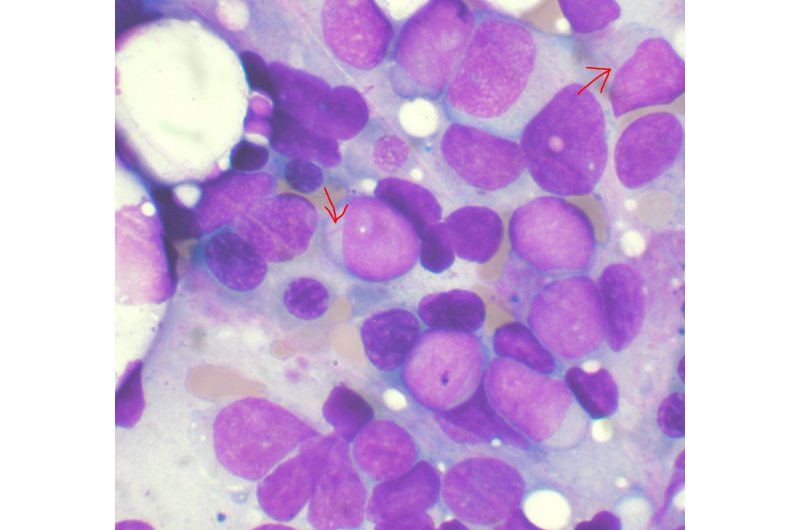Bone marrow aspirate showing acute myeloid leukemia. Several blasts have Auer rods. Credit: VashiDonsk/Wikipedia/CC BY-SA 3.0
Scientists at the Wellcome Trust Sanger Institute and their international collaborators have shown that Acute Myeloid Leukaemia (AML) is not a single disorder, but at least 11 different diseases, and that genetic changes explain differences in survival among young AML patients. Published in the New England Journal of Medicine, the ground-breaking study on the genetics of AML could improve clinical trials and the way patients are diagnosed and treated in the future.
In the largest study of its kind, researchers studied 1540 patients with AML that were enrolled in clinical trials. They analysed more than 100 genes known to cause leukaemia, to identify common genetic themes behind the development of the disease.
The researchers found that the patients were divided into at least 11 major groups, each with different constellations of genetic changes and distinctive clinical features. Despite finding common themes however, the study also showed that most patients had a unique combination of genetic changes driving their leukaemia. This genetic complexity helps explain why AML shows such variability in survival rates among patients.
Full knowledge of the genetic make-up of a patient's leukaemia substantially improved the ability to predict whether that patient would be cured with current treatments. This information could be used to design new clinical trials to develop the best treatments for each AML subtype, with the ultimate aim of bringing more extensive genetic testing into routine clinical practice.
Dr Peter Campbell, co-leader of the study from the Wellcome Trust Sanger Institute, said: "This is our first detailed look at how the genetic complexity of a cancer impacts on its clinical outcomes. Two people may have what looks like the same leukaemia down the microscope, but we find extensive differences between those leukaemias at the genetic level. These genetic differences can explain so much of why one of those patients will be cured, while the other will not, despite receiving the exact same treatment.
"We have shown that AML is an umbrella term for a group of at least 11 different types of leukaemia. We can now start to decode these genetics to shape clinical trials and develop diagnostics."
Acute myeloid leukaemia (AML) is an aggressive blood cancer that affects people of all ages, often requiring months of intensive chemotherapy in hospital. It develops in cells in the bone marrow.
This study shows that by using a comprehensive approach, scientists will be able to understand the complex interplay between the genetic changes seen in a cancer and the clinical outcomes of that cancer. This requires full genetic analysis of samples from large numbers of patients matched with detailed information about the treatment and survival of those patients. Further research into leukaemia, and indeed other cancers, will allow researchers to understand the patterns of how the disease develops and how patients are going to respond to treatment.
Prof. Hartmut Döhner, Medical Director of Hematology/Oncology at Ulm University and chair of the German-Austrian AML Study Group, said: "This landmark study has showcased the importance of international collaboration between academic institutions and clinical trials and the large scale of the study. These results represent a major step forward in translating the exciting findings from molecular genetics into better disease classification, diagnosis, and improved care of our patients with acute myeloid leukaemia."
Dr Elli Papaemmanuil, joint first author from the Sanger Institute and the Memorial Sloan Kettering Cancer Centre in New York, said: "Leukemia is a global problem with poor outcomes for most patients. We combined detailed genetic analysis with patient health information to help understand the fundamental causes of AML. For the first time we untangled the genetic complexity seen in most AML cancer genomes into distinct evolutionary paths that lead to AML. By understanding these paths we can help develop more appropriate treatments for individual patients with AML. We are now extending such studies across other leukaemias."
More information: E. Papaemmanuil and M. Gerstung et al. (2016). Genomic classification and prognosis in acute myeloid leukemia. New England Journal of Medicine.
Journal information: New England Journal of Medicine
Provided by Wellcome Trust Sanger Institute





















